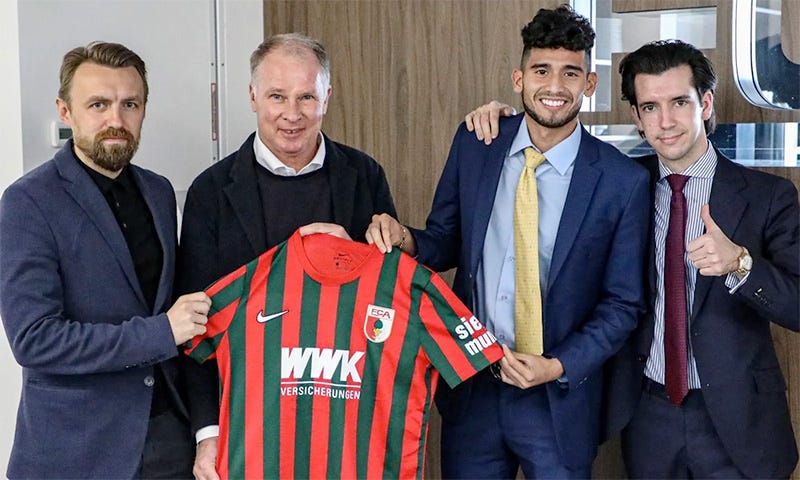

Discover more from Free Kick! from We Are Soccer
This week we saw two prominent US soccer players transfer to new teams. Daryl Dike went to West Bromwich Albion in the English Championship (second division of English soccer), and Ricardo Pepi is headed to FC Augsburg in the German Bundesliga. I get a lot of questions about how transfers work, as it’s not the same as what happens in American sports. Here in the USA, major sports teams trade players, or draft picks. In soccer, transfers are the norm, and they are done a little differently. We’ll quickly break it down for you here so you have a better understanding of what happens when a player moves to a new team and how it works.
In pro soccer, a transfer is the action of a player under contract moving to a new club. The world “transfer” refers to the player’s registration and moving that registration from one club to another. Players can only change clubs during an official transfer window, which is set by the governing body of FIFA. Here are the dates of those windows for 2022.
January 2022 Window: Opened on Saturday 1 January 2022 and will close at 6pm ET / 3pm PT on Monday 31 January 2022.
Summer 2022 Window: No dates have yet been finalized, but generally the window opens in early June and closes on August 31. FIFA rules say that there should be one window that may not exceed 12 weeks.
Transfer windows were established as a part of the negotiations with the European Commission to preserve contractual stability for players and teams. Although used previously by many European leagues, the current transfer window rules were officially instated by FIFA in the 2002-03 season. Despite some leaders looking to refine the process or revert back to old systems, the transfer window system remains in place today with each competition's governing body determining the exact dates, regulations, and exceptions.
So how does a transfer work? If a club wishes to purchase a player from another club, they must make an official inquiry to the club holding that player’s registration and contract. If the club with the player’s contract is open to selling the player, they will negotiate a fee with the buying club. While that is happening, the purchasing club can begin negotiating a contract with the player and his advisors. Once a fee has been agreed between the two clubs, the paperwork is then sent to the league office to be checked. Once all is approved, the player can sign a contract with the purchasing club.
Let’s use the Ricardo Pepi example to show how this works. Please note that it’s slightly different as Pepi was in the MLS, which holds players’ contracts, and not the club (FC Dallas), who he played for.
FC Augsburg were interested in purchasing the player from FC Dallas/MLS. They entered into negotiations and agreed on a fee of $20M for the player to move from the MLS to FC Augsburg. That fee can be paid in one lump sum, or it can be negotiated to be paid over the course of a couple of years. Once that fee was agreed, FC Augsburg enter into negotiations with the player for a contract. All paperwork was submitted to the Bundesliga (the league in Germany in which FC Augsburg plays). Everything was approved and finalized, including the player’s contract, and he was unveiled as their newest signing.
As you can see, there is a LOT of work that goes on behind the scenes.
The base transfer fee is the highest for a homegrown player in Major League Soccer history.
Along with the $20M fee that FC Dallas/MLS received for Ricardo Pepi, they also negotiated a 10% sell-on percentage going to Dallas in any future moves. So if Pepi is purchased by another club, 10% of that negotiated fee will go back to FC Dallas.
Can players refuse to be transferred?
With both clubs on board, it’s up to the player to confirm the transfer. After consulting with agents, lawyers, and other advisors, the player has the choice to accept or decline any transfer. This might seem backward, but remember, the club offered the player a contract originally, and they are obligated to fulfill that contract once the player signed it. Just because the club wants to sell the player, it does not mean the player has to leave.
The player also has the right to request a transfer from their current club. A transfer request can be made by the player, but it is up to the club to comply with that request.
Players sometimes want to transfer to a new club as they may have lost their spot on their current team, and usually, transfers (the big ones anyway), mean more money for the player. Agents also try to work transfers, as they receive a percentage of the fee that is negotiated. Everyone gets a little piece of the pie when transfers happen.
This week’s FREE KICK! Newsletter is brought to you by the We Are Soccer FB Page
Catch our live show, interviews, weekly videos, and much more on the official We Are Soccer Facebook Page. You can also join in the group chats that talk about players, games, leagues, and a whole lot of other fun stuff! Join in today!
If you’re interested in sponsoring FREE KICK! Contact us at craig@wearesoccer.show.
Subscribe to Free Kick! from We Are Soccer
We are the premier soccer show, podcast, and newsletter for soccer fans of all ages.










